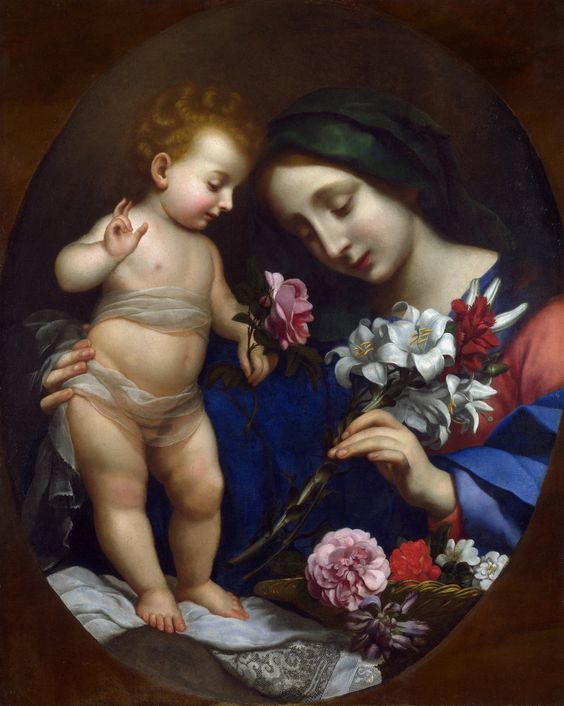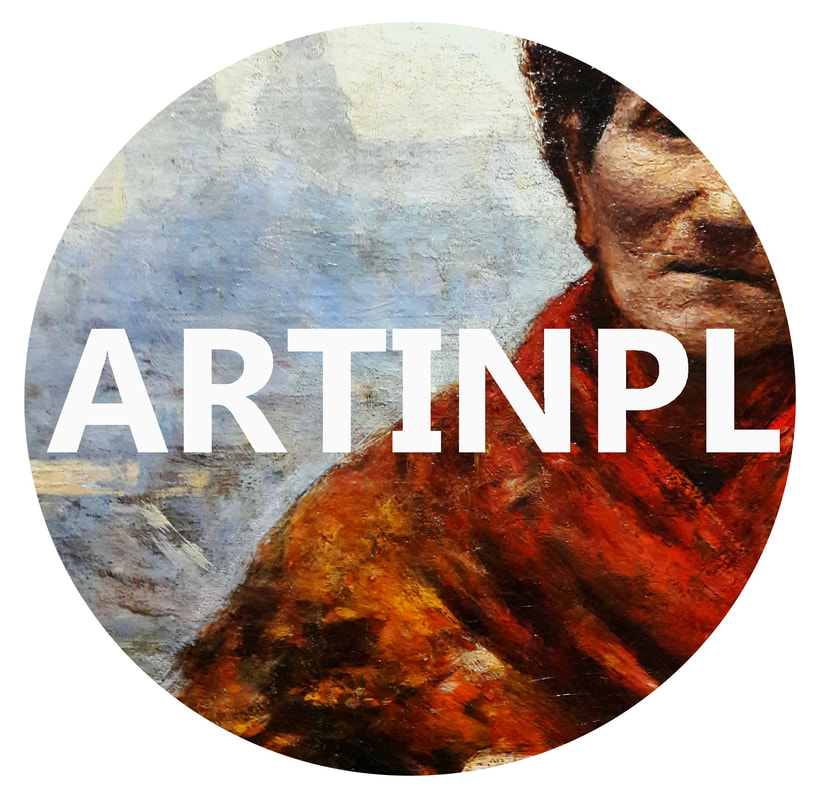|
After his abdication as a King of Poland in 1669, John Casimir Vasa left for France to settle in Paris in Abbey of Saint-Germain-des-Prés as its abbot. He took with him a large portion of the preserved Vasa collections, which was later sold in Paris on an auction in 1673 after his death. Inventory of the sell lists over thousand items:
(Extract) 55. A Christ carved in Saint Lucia wood, in an ebony box (Mr. Robert, griffier, 37.10 pounds). 56. Three Polish style chests with two wooden and another covered with black leather, as it is (Mr. Corade the Younger, 7 pounds). 57. A small bending seat covered with red velvet and a green velvet convenience chair, with a basin and two crystal chamber pots (Mr. Argilly, 9 pounds). 58. An altar frontal and two crédances in green velvet, trimmed with embroidery. 77. A large mirror of Venetian glass, trimmed at its edge, blackened and varnished, with its frame, gold and silver and silk (Madame Garnier, 131.10 pounds). 78. Dead Christ with Virgin made in wax, large as nature enshrined in a blackened wooden case with a large Venetian glass in front (Mr. Torque, 550 pounds). 79. A terracotta Virgin holding the infant Jesus, with two small crowns of enameled gold in a walnut box (Duke of Creguy, 20 pounds). 95. St. Peter painted on wood, original by Rubens, with its border of black wood (Mr. Corade, 40 pounds). 96. Virgin, infant Jesus and St. Elizabeth, painted on wood, with its black frame (Mr. Torque, 28 pounds). 97. St. Joseph holding the Child, with God the Father, the glory of little angels, original by Claude (?) Callot, in gold frame (Mr. Buy, 25 pounds). 98. Virgin in oval, holding a bouquet of lilies, a small Christ holding a rose, black frame with silver ornaments (Mr. de Buy, 104 pounds). 99. Head of the Virgin in oval with two hands, black frame with silver elements (Mr. Lenosquy, 25 pounds). 100. A rose with a bud and a golden sun, with a motto in golden frame (Mr. du Moulins, 55 sols). 101. Two small paintings of St. Ignatius and St. Francis Xavier, with ebony frames (Mr. Cavaro, 6 pounds). 102. Effigy of Our Lord in a velvet case (Mr. Meusnier, 4.10 pounds). 103. Virgin with St. Elizabeth and St. Joseph, copy after Nicolas Poussin, in a white frame (Mr. Morin, 33.10 pounds). 104. Christ's head with its golden frame (Mr. de Buy, 92 pounds). 105. Descent from the Cross of Our Lord, painted on wood, without frame (Mr. Vacherot, 9.10 pounds). 106. Christ's head with its golden border (Mr. Boislabbé, 6.5 pounds). 107. St. Ignatius in an interior, who heals possessed in black frame (Mr. de Recourt, 9.10 pounds). 108. St. Anne who teaches the Virgin to read, with little angels above, a crystal glass with gold frame (Mr. Mamice, 25 pounds). 109. St. Dorothy in a gilded oval. 175. Two maces, one in ivory and other one lined with ivory (Mr. Lévesque, 8 pounds). 176. A rhinoceros horn, adorned with gilded silver, with a small cup of same material with a foot trimmed with silver (Mr. Le Blond, merchant-silversmith, 86.10 pounds for the horn, Ms. Garnier, 24 pounds for the cup). 177. A large Turkey carpet, as is (Reverend Father Barré, 30 pounds). 178. A large resting chair, trimmed and covered with brocade. 217. A pair of gauntlets with two Turkish helmets. 218. A large clock that marks the hours at night, with an ebony pedestal, with silver index and gilded brass elements, three little cupids and a silver eagle (Mr. Dupin, 500 pounds). 219. A counterweight pendulum clock in a blackened wooden frame (Phillibert Paturel, 56 pounds). 220. A counterweight pendulum clock in with a small silver dial and a small decoration at the top (Mr. Macon, 56 pounds). 221. A clock striking the hours, half hours and quarter hours, in a walnut case topped with brass (Madame de Turin, 80 pounds). 222. A pendulum clock that marks the minutes, with a large pedestal box (Reverend Father Barre, 240 pounds). 223. A spring clock, striking the hours and minutes, with an ebony pedestal, a large cross of white brass at the top and a crystal skull at the foot of the crucifix (Mr. Barbier, merchant-silversmith, 304 pounds). 224. A watch clock striking the hours, half-hours, quarters and repeats, marking the minutes, with a silver dial and a frame of gilded copper, adorned with embossed silver plate and foliage (Mr. Dupin, 230 pounds). 225. A pendulum clock, as it is (Mr. Galus, 220 pounds). 226. A clock that marks hours, half hours, the fourth months and moons and moon signs, all movements of steel instead of string, with an ebony and blackened wood pedestal, adorned with several figures in gilded brass and an eagle on top of the dial, with the coat of arms of the late Queen of Poland (Marie Louise Gonzaga), enamel on copper (Mr. Dupin, 160 pounds). 227. An alarm clock striking hours, half hours and quarters, which marks the month’s quarters, the holidays, the year, pendulum decorated with several silver foliage, gilded brass pedestal and such wood with a fortune above (Mr. Le Riche, 311 pounds). 228. A brass clock striking hours, half hours and quarters, with alarm (80 pounds). 232. A clock striking hours, half hours and quarters, moon signs, days of the week, the twelve signs of the seven planets, parts inside with chains, on ebony pedestal, the case adorned with ornaments made in gilded brass with an eagle above (Madame Pachau, 205 pounds). 233. A counterweight pendulum clock in a case of blackened wood, with brass plaques around which are engraved in gilded panoplies, copper whitened dial (Mr. Hardevillers, 46 pounds). 234. A clock on an ebony pedestal, which marks the hours with two globes both sides of the dial, one silver the other gold brass, with two small compasses at the bottom and a large compass made in gilded copper above and sphere made of gilded brass behind. 357. A small painting with a lemon on a plate and a silver overturned vase, in ebony frame (Mr. Clorasse, 6.10 pounds). 358. St. Joseph with infant Jesus, trimmed frame (Mr. Corade, 6.5 pounds). 359. A miniature on vellum, with ebony frame, representing the Crucifixion of Our Lord, with several figures, original by Hreusebon (Mr. Dupin, 71 pounds). 360. A painting of a woman with small children, frame adorned with ebony, original by Mactence (Mr. Corade, 21 pounds). 361. A vertical painting with a garland of fruits and an oval in the middle, vaubours figures and landscapes and fruits of obreville, original by above-named Masters (Jan Brueghel?), in a gilded frame (Mr. Bodin, 415 pounds). 362. A painting with a perspective of the Church in Gdańsk, without frame (Mr. Corade, 40 pounds). 363. A painting with Our Lord on the cross between two thieves, copy after Rubens, painted on copper, in black frame. 389. A head of Christ painted on copper, in ebony frame (Abbot de la Tour, 11 pounds). 390. A perspective of a temple with festivities, painted on wood, in a frame of blackened wood with gilded slats (Mr. Quesnel, 40 pounds). 391. A monk's head, in a black frame (Mr. de Buy, 35 sols). 392. A half-figure of weeping Heraclitus (Mr. Mauriceau, 38.10 pounds). 393. The portrait of a monk holding a cross in his hands, painted on canvas (Mr. Corade, 110 sols). 394. A half- figure of laughing Democritus, original by Hendrik Goltzius (with 392). 395. The Conversion of Mary Magdalene with a cross, a skull, painted on canvas, without frame (Mr. Corade the Younger, 10.10 pounds). 396. Judith with the Head of Holofernes, painted on canvas, no frame. 439. A large vertical painting with St. Joachim and St. Anne who teaches the Virgin to read, with angels, painted on canvas (Mr. Duchemin, 41 pounds). 440. A picture painted on canvas, which shows a naked woman, without frame (Mr. Bruny, 16.10 pounds). 441. A Satyr who eats from a pot with a peasant, a story from Metamorphosis (Mr. De Buy, 35.10 pounds). 457. A painting of medium size, with the Virgin's Genealogy, copy after Raphael, black frame (Mr. Bonhomme, 36 pounds). 458. A painting which shows a Virgin in Glory, with adoring King at the bottom and Saint John, original, in black frame (Mr. Torque, 21 pounds). 459. A small canopy of crimson velvet, trimmed with gold and silk, tailless (Mr. Ollivier, upholsterer, 151.10 pounds). 480. Twelve broken (folded ?) ebony chairs, trimmed at their edges with upholstery of red velvet embroidered with gold and trimmed with fringe, gold and silk, accompanied with twelve cushions, also of red velvet embroidered with gold on one side only (Madame Garnier, 250 pounds). 481. Two large parade chairs covered with velvet crimson, which wooden feets, arms and other ornaments are made of Polish silver, sewn with pearls in other places. The said two armchairs are upholstered with velvet embroidered cushions with small gold glands (Madame Garnier, 1703 pounds). 630. A cane mottled with gold and silver with a screwing ivory handle and lower parts in silver (Mr. François, 56 sols). 631. A Cossack style baton made in a wood from India, with a lion’s head at the end and a silver hoop (Abbot de la Mothe, 6 pounds). 632. A baton of the late King of Poland made in a wood from Brazil, set with gold at both ends (Mr. Rondet, 27.10 pounds). 646. An ebony cabinet with two doors with drawers, with an inkwell and compact with two small lids and two rings of Polish silver (Mr. Dupin, 120 pounds). 647. Another cabinet, similar to above one, with silver settings (Mr. Dupin, 38 pounds). 648. An ebony checkerboard with black and white checkers, and a game of chess. 649. Eight high-warp tapestries representing the Life of Solomon, and four other high-warp tapestries representing Saul and Solomon, 54 French ell width altogether by 3.5 French ell high, the twelve pieces constitute two hangings (Mr. Maré, 1413 pounds for seven pieces, the said Mr. Maré, 1002 pounds for five pieces). 650. A walnut cabinet of on a twisted column, topped with several drawers and small plates of gilded copper serving as an ornament; a table and two similar wooden pedestals (Mr. Gallois, 120 pounds). 651. Fifteen pieces of tapestry of red velvet and gold brocade, 36 French ell width altogether by 2.3 French ell high, and twelve pieces of crimson red velvet, embroidered with gold and topped with a fringe of gold and silk, sloping from the said tapestry containing 36 French ell (Mr. Huvin, upholsterer, 2251 pounds). 655. A large gilded carriage for six, upholstered with Venetian velvet in palmettes on aurora background and blue flowers, with glasses and set on a chassis (sold by Mr. Torque). 656. A small carriage, upholstered with Venetian velvet in palmettes on aurora background and black flowers, with three glasses and set on a chassis (sold by Mr. Torque). 657. A large mourning carriage draped in black in and out, without glasses and set on a chassis (sold by Mr. Torque). 721. Four large plates, eight small, round basin, a jug with a cover, a saltcellar and dozen plates. Made of sounding pewter (Mr. Bourgeois, 43.02 pounds). 722. A large basin with figures in relief, accompanied with a vase, made of gilded German silver, on which is represented the horse Pegasus and the figure of Mercury, 62 marks and seven ounces of weight (Mr. Gerard, merchant-silversmith). 726. A ring with a purple ruby carved on eight sides with six faceted diamonds (Mr. De Buy, 1200 pounds). 727. Another ring with a long purple sapphire with six faceted diamonds (Mr. Macon, goldsmith, 600.10 pounds). 728. Ten pieces of Brussels’ tapestry representing the story of deeds of Ulysses (by Jacob Geubels), including parts sewn with gold, containing 56 French ell width by 3.5 French ell high (Mr. Dupin for Mr. Paul, agent of Charles I Louis, Elector Palatine, 12,000 pounds). 729. Four other pieces of Brussels’ tapestry representing the Deeds of Hercules and Triumph of Bacchus, sewn with gold containing 22 French ell width by 4 French ell high (Mrs. Bruneau, stored in the furniture repository of His Majesty close to the Louvre, 16001 pounds). Inventory made in Nevers 1. A tapestry of 40 strips of Venetian brocade, with slopes and fringe in various colors (Mr. de Buy, 400 pounds). 2. Thirteen ell of tapestry of 7 pieces, 2.5 French ell high, from Venetian brocade (not sold and left in Nevers). 3. A bed of wood with a red satin mattress; a bed and pillow filled with feather and covered with red taffeta, a pavilion with lining of brocade “Porte de Paris”; a green silk cover, with 3 bags of leather (Madame Filogue, 220 pounds). LL XII. Four portraits of four Princes of Neuburg (Mr. Corade, 12 pounds). CX LL. Amazon painted on canvas (Mr. de Buy, 110 sols). LL VI. A portrait of a Maltese Commander (Zygmunt Karol Radziwiłł?), painted on canvas (Mr. de Buy, 6 pounds). LI LL. A painting on canvas depicting St. Casimir, in a trimmed frame (Mr. Bodin, 51 pounds). CX S. Another painting also painted on canvas, depicting St. Casimir (Mr. Corade, 110 sols). LX LL. Portable chair, covered in black cloth (Mr. Bourguignon, 60 pounds). XXX S. A portrait of a Polish Prince (Mr. Corade, 30 sols).
Virgin and Child with flowers by Anonymous after Carlo Dolci, after 1642, National Gallery in London, was listed under number 98 of the King's belongings.
See more pictures of the Royal Castle in Warsaw during the Vasas on Pinterest - Artinpl and Artinplhub
Comments are closed.
|
Artinpl is individual, educational project to share knowledge about works of art nowadays and in the past in Poland.
If you like this project, please support it with any amount so it could develop. © Marcin Latka Categories
All
Archives
April 2023
|





